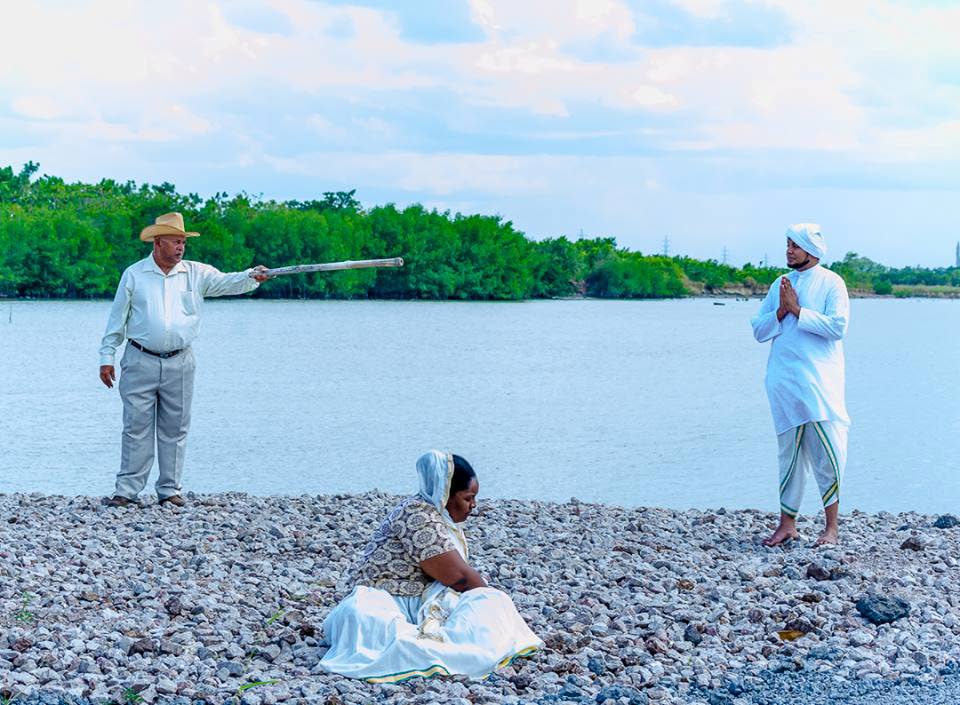Temple in the Sea for Sapa

It’s the third staging of the play by Iere Theatre Production, which under the direction of playwright Victor Edwards, mounted the play in 2002, 2012 and will again do so this week.
Written back in 1995 by some students from The UWI’s Department of Creative and Festival Arts, under the directorship of Rawle Gibbons, in commemoration of the 150th anniversary of East Indian Arrival, Edwards is motivated by several factors for restaging the play.
Firstly, his desire to have the popular site, noted for worship as well as a tourist attraction, be declared a national heritage site and secondly to educate the population that such a temple exists in Trinidad at Waterloo.
“It may have an East Indian background in terms of the temple, but it is a national heritage site. It is a place of love and worship for people of all race and religion and we need to get people to see and understand that.”

and Geneva Drupaulsingh (narrator), part of the musical cast from the Iere
Theatre Production Ltd’s Temple in the Sea, prepare for the show.
Secondly, the retired schoolteacher and theatre arts curriculum coordinator with the Ministry of Education, said he was amazed when talking to theatre arts students who were interviewing him for their school-based assessment (SBA), they were not aware there was an actual temple in the sea.
“Apart from that, the quality exhibited in the whole episode of building the temple that took him 25 years, the qualities such as perseverance, determination, doggedness, longevity and dedication to purpose. Those are the qualities that our society need to conduct, adopt to become a successful nation,” Edwards said. The story explores the ultimate triumph of Siewdass Sadhu, a devout Hindu and indentured labourer, who found his space in the Trinidad landscape in spite of challenges from the colonials and modern-day politicians to keep the promise he made to God to build a mandir (temple).
Identifying the Gulf of Paria like the Ganges River, near where Sadhu was born, the process to build the temple by the seashore began. Using a bucket and a bicycle to transport material, he completed the dream amidst mockery and ridicule from those who could not identify with his vision
Years later, he was ordered to demolish by the private landowners who did it themselves when he refused. His refusal landed him in jail and a fine. But a commitment to purpose saw this simple, quiet man using the lessons learnt in the Ramayana to rebuild, this time, 500 feet into the sea on reclaimed land.
Edwards notes, “This is really a story of perseverance and commitment to purpose and the sacrifices made. The play demonstrates his knowledge of the Ramayana and how Sadhu is able to use the knowledge to apply to his situation.
“The big lessons for all Hindus is that we cannot be trying to recreate India in Trinidad, but what we can do is use the knowledge we have brought with us from India and use that to make our lives here relevant to our new situation. I think this is what Iere Production does. We are not writing and doing plays about India, but we are doing plays which shows how East Indians have adapted their lives in many aspects to suit this new environment in which we exist.”

Edwards said in this way, the theatre and the drama become relevant to the society. “We believe the drama must always have that kind of social construct and the people who are coming to see the drama must look at it and see themselves and take lessons out of the drama to inform and improve their way of living and their lives. That is why we are doing it.”
To bring relevance to TT in the 21st century, the director has injected extempore to portray the mockery and ridicule Sadhu faced. A couple of contemporary political issues, including the 2018 threat of the dismantling of a mandir at South Oropouche, is also included. Three school shows, one for primary schoolchildren will be held on Thursday at 9 am at Sapa, a second staging at 12 pm and a third on Friday at 9.30 am. Three shows will also be staged for adults at 8 pm on Friday and Saturday, and 6 pm on Sunday. Two patrons will get in on one special-priced ticket on Friday.

Comments
"Temple in the Sea for Sapa"